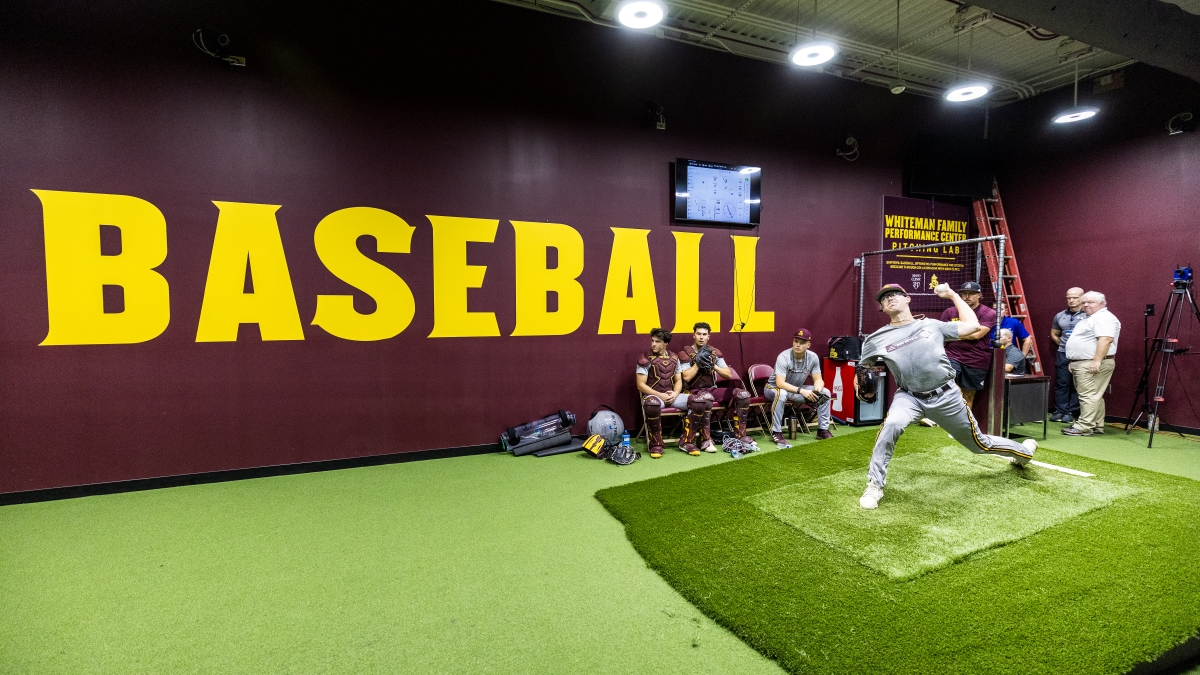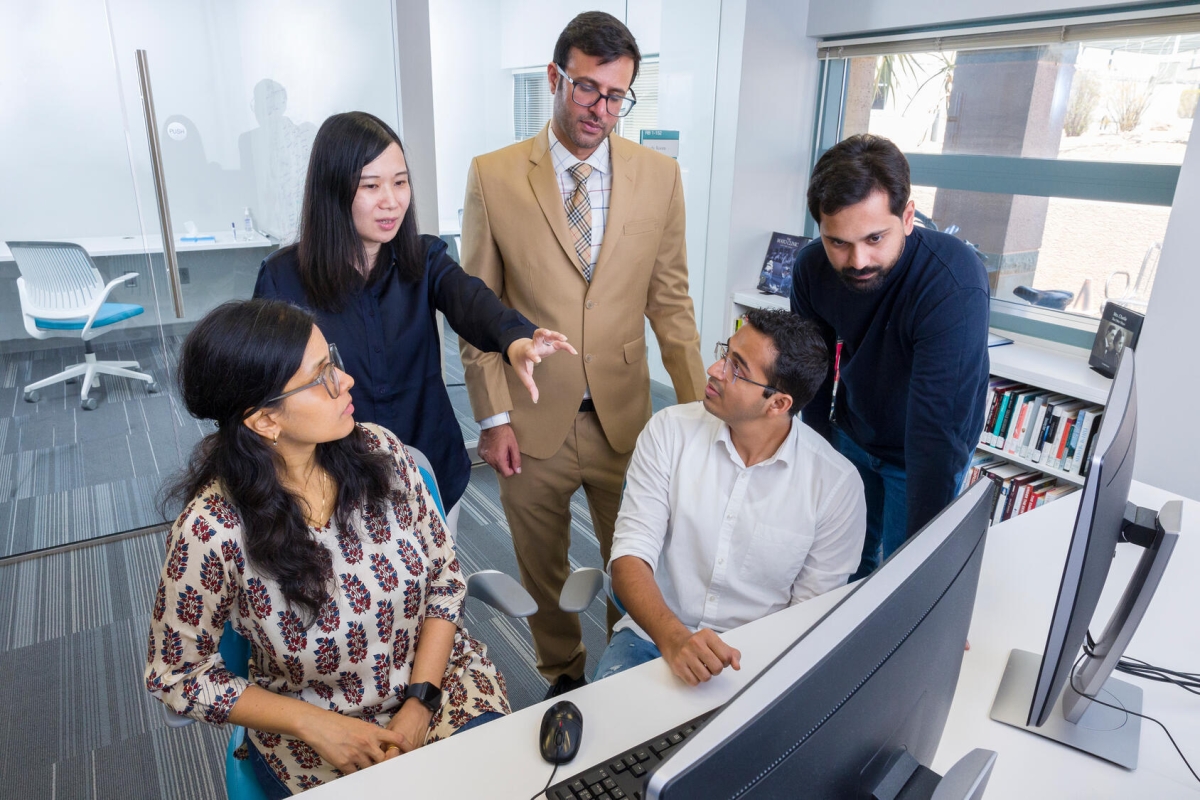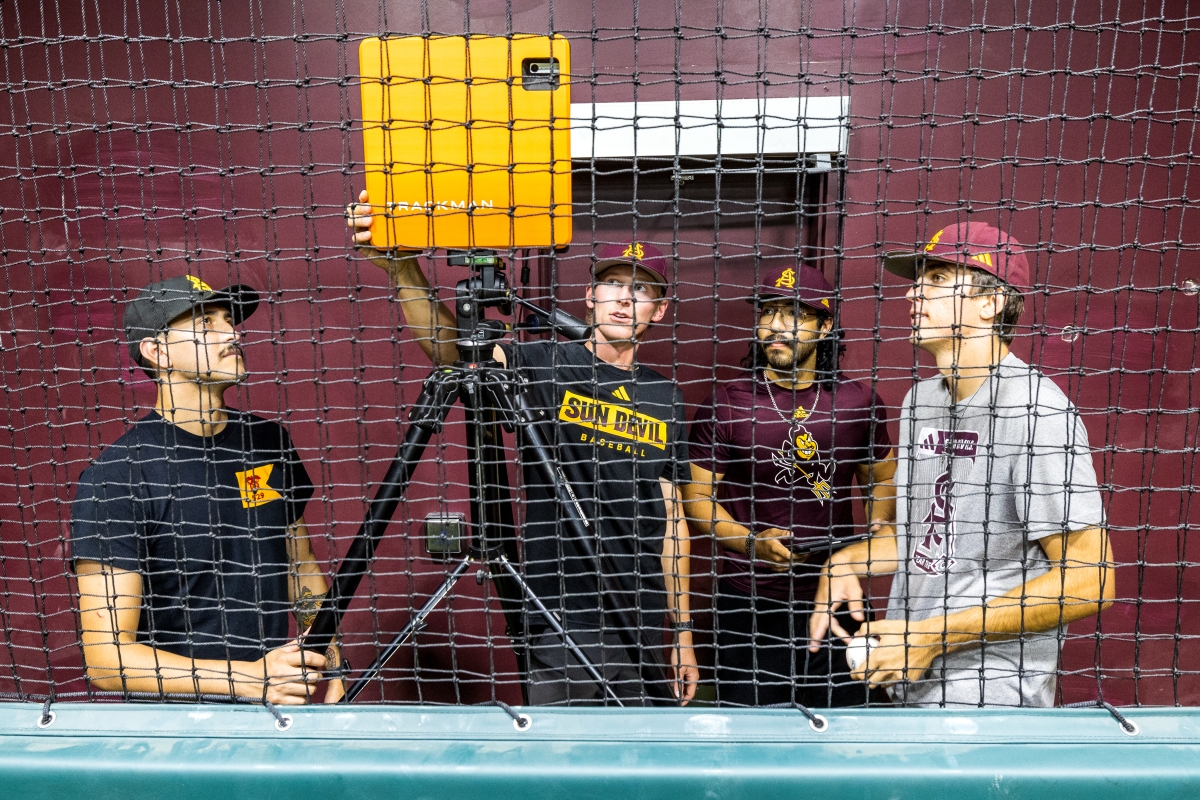Innovative, fast-moving ventures emerge from Mayo Clinic and ASU summer residency program

Members of a Mayo Clinic-ASU summer research teams focused on orthopedic surgery and baseball injuries watch as third-year left-hand pitcher Ben Jacobs throws a session in the indoor bullpen filled with high-speed cameras of ASU’s Phoenix Municipal Stadium on Sept. 20. The research project was based on the need to help find ways to reduce the incidence of shoulder and elbow surgeries in youth baseball pitchers. Photo by Charlie Leight/ASU News
By Georgann Yara
In a batting cage transformed into a custom pitching lab, tricked out with the latest in sports technology, Charles Leddon and his Mayo Clinic research teammates scrutinize the biomechanics of pitching.
A better understanding of a pitcher’s performance — what the arm endures during every hurl and how to prevent injuries that could end promising careers, even before some of them have started — is the goal. The hope is that this quest will one day have an invaluable impact on the sport that could eventually extend beyond baseball.
“It gives us the opportunity to see a little deeper as we help the baseball team and medical community figure out some of the issues we've had in baseball with injuries to the arm,” says Leddon, an assistant teaching professor of sports science and performance programming at ASU's College of Health Solutions.
The project is driven by the three-pronged force of ASU research and academics, Sun Devil Athletics and Mayo Clinic. This collaboration will have a direct impact on justifying rehab, possible reinvention of a pitcher’s style and perhaps what kind of pitches they can throw by quantifying risk, explains Dr. John Tokish, sports medicine physician and orthopedic surgeon at Mayo Clinic.
He also sees the potential impact on youth players.
“I’m the guy we want these athletes to avoid seeing if they get injured,” says Tokish, who has extensive experience in shoulder and upper-arm surgery. “This is truly a collaboration between science and athletes. … The ultimate goal is to learn enough about this to prevent them from ending up on my table.”
The Mayo Clinic crew also includes physical therapist John Zajac, senior program coordinator of orthopedic surgery Carter Jones and Dr. Matthew Anastasi, a family and sports medicine specialist.
“We would like to bring this to the masses and try to come out with results that are applicable to everyone across the board in terms of the overall athlete,” Anastasi says.
The venture is among many emerging from the Mayo Clinic and ASU Alliance for Health Care, a 20-year partnership between the two entities renowned for their innovation. This alliance’s seed grant program encourages new collaborative research projects, like those selected for this year’s Faculty Summer Residency Program — whose research, despite the name, often extends into the fall. Here, participants from ASU and Mayo Clinic unite to get life-changing works into motion, enabled by the support from the alliance.
Saving voices with new MRI technology
Dr. Tanya Rath, a Mayo Clinic diagnostic neuroradiologist, attests to this regarding the research that she and Sung-Min Sohn, assistant professor in ASU's School of Biological and Health Systems Engineering, have embarked on in the MRI realm — specifically, in diagnosing and treating disorders of the larynx and throat.
“It may improve the ability to image disorders of the throat and improve ability to provide care for cancer patients who are at risk of losing their voice,” Rath says. “This would be really hard without this partnership.”
Mayo Clinic is one of the few sites in the nation to have a MRI scanner with the magnetic field strength of 7-Tesla — more than double the strength of the standard scanner for clinical use.
Rath, who specializes in head, neck and central skull base imaging, envisions the creation of a coil that will harness its power to focus on the neck, a tricky spot due to the variation of size on patients as well as the positioning above the shoulders.
Rath and Sohn are working on a prototype, and although it will take years for their work to get out in the field, the potential payoff will be worth it: more accurate diagnosis and ultimately better treatment and care.
Sohn hopes the flexibility and stretchability of their coil will make the difference with what he describes as the most powerful MRI scanner yet.
“Thanks to this collaboration with Mayo Clinic, there are future opportunities for more research and programs,” Sohn says.
Weaponizing AI in the war on skin cancer
Distilling mountains of data that would be overwhelming to most people is routine for Minseok Ryu, assistant professor in ASU's School of Computing and Augmented Intelligence.
However, Ryu recently entered into new territory when his expertise in developing algorithms dovetailed with Mayo Clinic dermatologist Dr. Aaron Mangold’s professional battle against skin cancer, which strikes 5.4 million in the U.S. each year.
With Mangold, who specializes in rare inflammatory diseases and skin cancers, and his access to data, Ryu is able to develop a comprehensive AI tool to assist pathologists in risk assessment.
“Before, I would look at math and put it into algorithms without knowing the importance of this in the real world,” Ryu says. “With Aaron, he has tons of real-world data and real people, and I liked that. It’s the motivation to keep working with Mayo and Aaron. It's a unique opportunity for my side.”
For Mangold, he’s not only looking at early detection and saving lives. He’s also interested in the significant percentage of patients who are diagnosed with skin cancer that does not prove fatal. With Ryu and his mastery of AI, Mangold aims to identify those who are not severely at-risk and avoid overtreating them, which brings its own set of negatives.
“The beauty of Minseok’s focus is that we can apply his algorithms to deliver personalized management that hopefully saves lives, saves money and prevents overtreating cancers so we can more appropriately address patients’ needs,” Mangold says.
Starting locally, growing globally
The unique relationship fostered by the alliance and its Summer Faculty Residency Program cuts through much of the red tape that can stymy research projects, especially in the health care sphere. Mangold says this collaboration between the two entities allowed him and Ryu to do “pretty cool work quite quickly,” whereas other partnerships in his previous experiences did not.
“The alliance was nice,” Mangold says. “It was a relatively low-stress, enjoyable process because both institutions have worked together on how to figure this problem out.”
The seeds of such pioneering ventures made possible by this collaborative effort are planted locally. But that’s far from their ultimate reach.
These projects may seem to have little in common, but what they do share is a global vision, explains Mayo Clinic senior program coordinator Carter Jones, who handled much of the coordination among key personnel for the pitching biomechanics program.
“Having this pitching lab with ASU certainly helps from a recruiting standpoint because they are one of the first of this kind to have this level of technology and collaboration between a health organization like Mayo Clinic and the direct access to the clinical team with the coaching staff,” Jones says. “And it’s only going to get bigger.”
And this kind of innovation is just the starting point — in sports, health care and beyond.
More Health and medicine

ASU honors students work on HPV research as part of Barrett College's largest-ever group thesis
Not every undergraduate student comes across the opportunity to do research as part of a team. Even fewer have had the chance to join a team of 86 students doing multidisciplinary research with real-…

College of Health Solutions alumnus named Military Medic of the Year
By Keri Hensley and Kimberly LinnJonathan Lu has looked out for the health of his fellow military service members his whole career, starting with his role as a combat medic in the U.S. Army.Driven by…

ASU, Mayo Clinic forge new health innovation program
Arizona State University is on a mission to drive innovations that will help people lead healthier lives and empower health care professionals to develop novel new health solutions. As part of that…


